A big thank you to Discover Corps for providing this moving voluntourism opportunity so we can share their good work. As always, all opinions are our own.
| See part one of this adventure | See part three of this adventure |
DAY FIVE: It’s a big job… and counting our blessings
Morning: (Un) Nailin’ it

Today our Discover Corps team is stepping into the role of construction crew with gusto.
We teach in the early morning, but the big job is getting the classroom we are refurbishing ready to go.
A huge first hurdle is cleared when we get all of the old ceiling removed, and cleaned out.
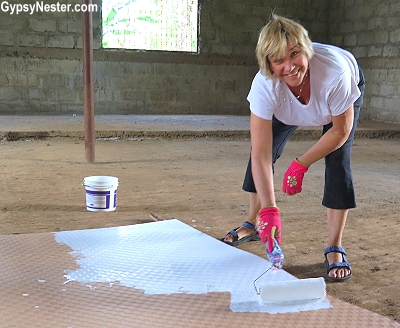
Now we can seal the holes in the tin roof to avoid any water damage to our new ceiling panels.
Speaking of the new panels, they are coming along nicely too.
Round one of the painting is almost complete.
By the end of the day we have things pretty well in hand and will be ready to begin painting when we return next week.

Kicking up dust: Veronica learns to use an African broom
While we clean and paint, the kids are coming to the school kitchen for lunch carrying their spoons and dishes.


One of the many challenges that Longuo Primary School faces is no electricity, so the kitchen is outdoors and the food is cooked over an open fire.
Provisions have been donated for a year by a good samaritan so the children can have a good meal.
Sometimes, for some, it is the only meal they get all day.

We were moved by a little one who had a tiny ball of rice. Instead of eating it by herself, she shared with many other children.
Mama Simba explains to us the concept of chakula ni mavi – food is nothing; remember what is important.
Food is always shared and given freely.
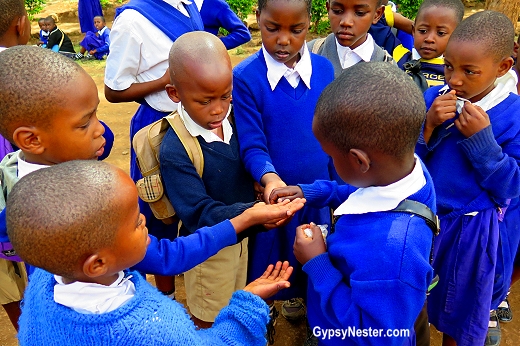
The noon meal almost always includes ugali, a staple of the Tanzanian diet that is a thick corn meal porridge.
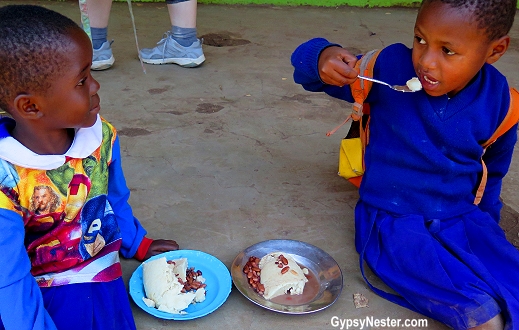
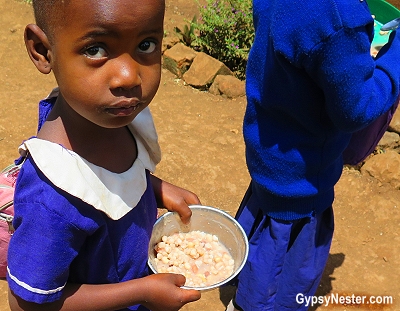
Other ingredients can be added, often provided from the garden at the school.
The kids tend to the plants each morning, watering from jugs that they bring from home.
We have had ugali at several of our meals as well.
See more about our time working at the school!
Afternoon: We are truly blessed
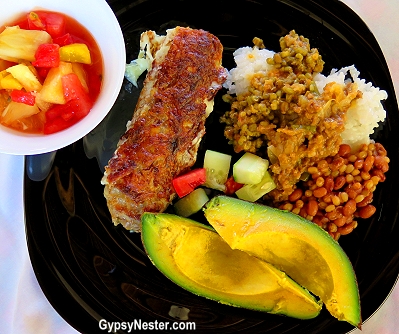
Mama Dinga, our extraordinary chef for the homebase, has introduced us to it, along with many other traditional specialties like cassava, cooked green bananas, stewed chicken, curry peas with coconut, and an absolutely incredible hot cucumber soup with ginger called supu ya tango.
Thinking back to our children at the school, we are reminded of how lucky we are.
Our afternoon is set aside for free time. Some of us work on lesson plans, others visit in the village and some of us head into Moshi to find supplies for the school.
We head to bed early. We have a 3AM wake up time for our visit deep into the seldom seen Massai lands…
DAY SIX: Meeting the Maasai, a man with 11 wives, and giraffe!
Early morning: A journey into the living past
We are up well before the sun today because we have a three-hour drive to visit the Maasai people.
As dawn breaks, we descend into the Great Rift Valley.
This region was home to homo habilis, likely the first early human species, about two million years ago, but the Maasai are relative newcomers, having migrated south from Kenya through the Nile valley over the past few centuries.
Driving along we see many of the distinctive huts, known as Inkajijik, that these nomadic herders use for shelter.
Several of these belonging to one family are grouped inside a protective barrier made from the thorny branches of the acacia tree to form a small village called an Enkang.
We drive the bus off the road to take advantage of a small patch of shade near an Enkang that is headed by a man with eleven wives and over seventy children.
Many of these family units of Maasai have fought to retain their way of life against the encroaching modern world, continuing to herd cattle, sheep, and goats on their ancestral lands.
WATCH THIS VIDEO!: It’s impossible to fully capture the Maasai through words and photos!
With introductions made, we follow two of the Maasai men who are acting as our guides away from the encampment and into the bush.
See more about our visit with the Maasai
We are only expecting to see the stark country of the valley and learn more about their lives, but there is also a large measure of hopeful excitement at the prospect of seeing giraffes in the wild.
After nearly an hour of hiking through the barren, dusty landscape, our anticipation is waning, but then a guide points out some poop. It is giraffe, and it is fresh.
Let the tracking begin…
Morning: A walk with warriors and giraffe
<

The next step is to find some tracks, and the fine soil made from ancient volcanic ash is perfect for that.
In no time we are in hot pursuit, making sure to do our best Elmer Fudd impersonations… be verwy verwy quiet, we’re hunting giraffes.
They blend in well but we spot our quarry in some distant trees and pick up our pace in an effort to catch up to them.
Soon we are within a few hundred yards, and while they are wary, they allow us to observe for quite a while.
We have also come upon a small herd of zebras nearby. The moment is magically mesmerizing and no one in the group moves or makes a sound.
Suddenly, the spell is broken, and both herds of animals break into a run.
Wow! We watch them run and it is as if they are in slow motion. Hearing and feeling their hoof beats as they pass makes the entire experience so tangible.
Then they are gone and our entire party stands in stunned silence, we can hardly believe we are actually living what we have only seen on film before. The walk back to camp is filled with excited chatter about what we just witnessed.
See more about our visit with the Maasai
Back at the Enkang, the Maasai men are preparing to slaughter and eat a pair of goats…
Early Afternoon: A world away… or maybe two
Back at the Maasai encampment the men are preparing to slaughter a pair of goats.
This is only done on special occasions, since both the goats and cattle are used more for their milk than meat.
The women stay behind, they have never been down the hill where the slaughter takes place, even though it is just feet from the encampment.
We’re more than a little freaked out about what is about to happen, yet also know that it is a privledge that few are afforded to see.
Two men hold each goat down and clamp their hands over the animal’s nose and mouth to suffocate it.
Not only was this easier on our delicate sensibilities, but there is no blood spilled in the killing.
Nothing is discarded; every bit of the animal is used in one way or another.
It is at this time that several of the men take turns drinking some of the blood directly out of the cavity.
The blood is an important source of liquid and nutrition in this incredibly harsh and dry environment.
WATCH: Learn about the Massai’s ritual goat slaughter and blood drinking (if you’re squeamish, you may want to skip it)
The next step is an obvious one; build a fire to roast the goat.
No matches necessary, the men make fire by spinning a stick placed on a dry branch.
The friction generates enough heat to create embers that are placed in dry donkey dung.
With a bit of blowing, flames appear.
Leaving the Maasai men to their eating of raw internal organs and medicinal soup preparations, we head to our own camp and enjoy an incredible outdoor bar-b-que prepared for us under the spreading acacia tree.
See more about our visit with the Maasai
Afternoon: Inside Maasai culture
Appetites appeased, we walk back within the fencing of the enkang for a look inside an inkajijik.
Each of the huts is occupied by one of the wives of the village leader; in this case there are eleven.
The small round building is divided into three rooms, and we sit in the main area while the chief explains the design and Mama Simba translates.
The construction is mostly wooden, large support poles hold up a thatched roof, with walls made of branches plastered over with adobe-like cement made from dirt, urine, cow dung, and ashes.
The main room serves as kitchen and meeting area with some storage space and an area where baby goats are brought inside each night.
The other two rooms are bed chambers, one of which is occupied by the wife, the other by the children.
The husband does not live here, he has his own hut and the wives take turns accompanying him there.
We are told that there is a set schedule and that the wives hold no jealousy.
Since the Maasai are a nomadic people, the entire structure is portable.
It can be dismantled and strapped to a donkey whenever the group needs to move to a new area for grazing the cattle.
Surprisingly, as important as cattle are in the lives of the Maasai, we never see a single cow. They are all away grazing, being tended by about half of the group’s members.
Just outside of the enkang the women have laid out jewelry that they have made.
Making beaded necklaces, bracelets, and earrings has long been a tradition for the Maasai.
Originally they made their own beads, then they began trading with European colonists for them.
Veronica chose a wide beaded bracelet with bangles. The colors represent peace and water.
As a farewell, we are given a send off song and dance.
The men enter first and perform what is known as the jumping dance while chanting and vocalizing a sort of low pitched drone.
The women follow with a call and response song where one sings a line and the rest of the group answers in unison.
The two groups continue simultaneously, almost as if they are competing with one another, and then simply stop.
To see our African journey from the very beginning, click here
We say our goodbyes and board our trusty little bus for the journey back to homebase with an incredible amount of experiences to process.
It is difficult to believe that they all happened in one day.
See more about our visit with the Maasai

DAY SEVEN: The little ones of Rau, and learning to batik like a Tanzanian
Morning: An incredible woman doing incredible things
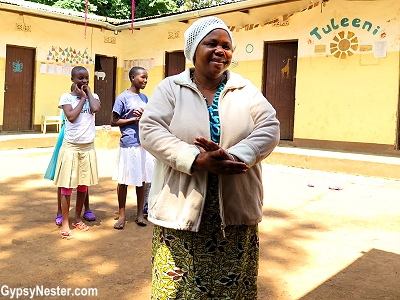
With all of yesterday’s excitement we are ready for a low-key day so, after a leisurely breakfast, we walk just a few blocks (even though we are fairly certain that they are not called “blocks” here) to the Tuleeni Orphans Home.
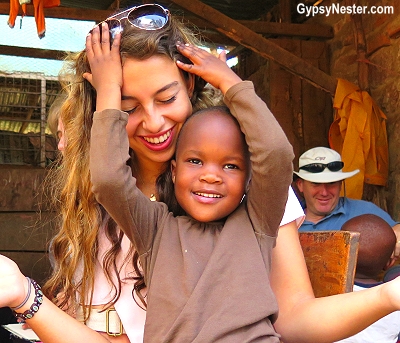
The children greet us warmly and then we all sit down for a little bit of a chat with Mama Faraji, who has been helping orphans for over thirty years.
She has dedicated her life to the orphaned babies of Rau and sees this as her home (the infants and toddlers actually live in her home) and the kids as family.

As a teen she was orphaned herself and she raised her siblings, then others began to bring children to her and she took them in too.
She simply couldn’t refuse a child in need. Today the home serves about one hundred youngsters.
We immerse ourselves into the throng of kids, introduce ourselves, read stories, play games, and share a treat or two.
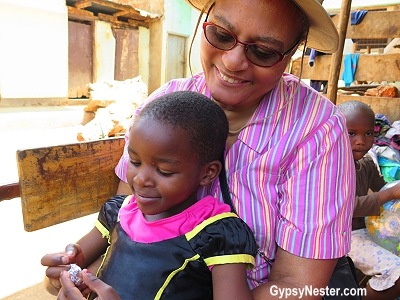
As we have found throughout this corner of the world, the Tuleeni Orphans Home and its residents have adapted to getting along on very little while maintaining an inspiring, and bright outlook on the future.
Our afternoon is dedicated to bringing out our artistic qualities, which seem to be fairly well concealed.
A group of artists come to visit at the homebase and we will attempt to teach us the art of batik.
The process uses colorful dyes, controlled by wax on cloth to create images.
We are each issued a piece of fabric and a pencil and begin our attempts at sketching a picture that will then be dyed into the material.
Looking around the table we see many somewhat pained expressions on the faces of our Discover Corps mates, some with the classic tongue hanging out and slightly bitten.
Once we manage something resembling a drawing, wax is applied to the areas we want to remain white.
First the background colors we have chosen are laid on.
Once dried over an open fire, another round of wax is applied everywhere but the areas we want silhouetted.
Now we are able to color the areas without wax free from the worry of the dye going where we don’t want it.
Next we rub the fabric together vigorously to remove the wax and then run a hot iron over our cloth to melt any remnants.
Viola! We have our masterpieces.
Many members of our group made very impressive scenes, however David’s elephant’s head looks more like a cassowary than a pachyderm.
On the other hand, Veronica managed a rather clever adaptation, an African version of the cover of our book, Going Gypsy: One Couple’s Adventure from Empty Nest to No Nest at All.
See more about our batik experience – with step-by-step directions and more photos!
DAY EIGHT: Climbing Kilimanjaro, Banana Beer and a Chagga Apology
Morning: Nature is an uphill battle
Our entire Discover Corps team is all atwitter as the sun rises this morning.
We have been catching glimpses of Kilimanjaro over the past week and a half, but today we get to set foot upon the massive mountain.
We will not be getting anywhere near the top though, after all, we’re talking about the biggest freestanding mountain in the world here, rising over nineteen thousand feet!
We drive up to an elevation of about five thousand feet to begin our trek. At this altitude the terrain is classic rain forest, and the misty precipitation shows us why.
The trail leads us to the first of the three waterfalls we will visit today. Gingerly walking across a span of wet, slippery rocks allows us to test the water.
Considering we are within a few hundred miles of the equator, it is surprisingly cold. On the other hand, there is quite a bit of snow and ice above so maybe we should have expected it.
As we climb higher we pass through a couple of secluded villages and the small, terraced farm fields that are typical of the Chagga people who inhabit the southern and western slopes of the mountain.
For centuries they have been growing corn, beans, squash, coffee, and mainly bananas in this region.
We stop at a little shop / bar to have our lunch and an ongoing conversation picks up again. We have been asking Mama Simba, and locals that we meet, about a favorite traditional brew in Tanzania called mbege for several days. It is a type of beer made from millet and flavored with banana, but it is not sold in stores, only homemade.
Richard from homebase, who has joined us on our climb, feels like we might be able to find some in this village, so he heads out to scout.
When he arrives back, he could only find a different beverage which the label proclaims to be “Quality Banana Drink” and “Banana for my health.”
Learn more about the Chagga people of Kilimanjaro
Popping it open, the bouquet was bad, but not even close to the taste.
After a sip we begin to speculate on the recipe. Our best guess is that they begin with a grimy bucket filled with giraffe urine (we surmised this from the pictures of giraffes and a bucket on the label), add a burnt log (for that smoky flavor) and let that steep for a few days.
Next add some old, rotten, black banana peels (for your health) and a dash of diesel fuel, and set aside again to ferment for a week or two.
Now the cocktail is ready to be strained through a dirty sock into used beer bottles (keeping the original user’s backwash is optional), but notice that a good amount of sediment makes it through.
Serve lukewarm… oh, and we highly recommend keeping water handy to chase it down. Lots of water.
When we told Mama Simba about the drink her comment was, “people drink this and go crazy.”
We certainly can believe that.
More on our assault on Kilimanjaro!
Afternoon: If you can’t climb it, drink it
Setting out after lunch our guide, Alfred, regales us with stories of his many triumphant assaults on the summit of Kilimanjaro.
He says that has conquered the mountain more times than he can count, including trips guiding Sylvester Stallone, Ice Cube, Martina Hingis, and many other celebrities from around the world.
He also demonstrates the bushman click language, which is his native tongue. His attempt to show David how to speak it can be described as futile, at best.
He also explained how burnt giraffe bones will draw the poison out of a snake bite, and how this method saved him from a green mambo strike.
After climbing nearly a thousand feet, we reach the third waterfall. This puts us just a hop, skip, and a jump away from our destination, the Marangu Gate into Kilimanjaro National Park.
Along the way Alfred gives us one more story.
He picks a leaf from a palm-like plant, ties it in a knot, and places a one thousand shilling note inside the knot.
Local Chagga legend has it that if anyone offers this to someone they have wronged, the slighted party is expected to forgive and forget. We couldn’t decide if it is a lovely way to keep the peace, or an overly simple get-out-of-jail-free card.
Learn more about the Chagga people of Kilimanjaro
Next thing we know we are at the gate where most climbers begin their assault on the summit.
Even though it seems like we put in a pretty good hike to get here, completing the climb is another thirty-four kilometers up over thirteen thousand feet.
That won’t be happening today.
More on our assault on Kilimanjaro!
In fact, the gift shop had the proper sentiment for our sort of expedition on a tee shirt, “If you can’t climb it… Drink it!”
Since Kilimanjaro has become our new favorite beer, it seemed more than fitting… Wait! There’s more! Continue along with us on our adventure…
To see our African journey from the very beginning, click here
| See part one of this adventure | See part three of this adventure |
David & Veronica, GypsyNester.com
A big thank you to Discover Corps for providing this moving voluntourism opportunity so we can share their good work. As always, all opinions are our own.
Delve Deeper:
See more of our visit with the Maasai
More on our assault on Kilimanjaro!
Click to see all of our adventures in Africa!
YOUR TURN: Can you believe the color and energy of Tanzania? Are you as mesmerized as we are? Have you taken a volunteer vacation? Tell us about it!


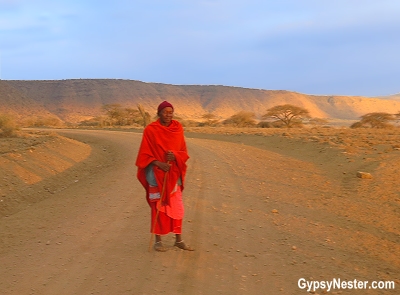
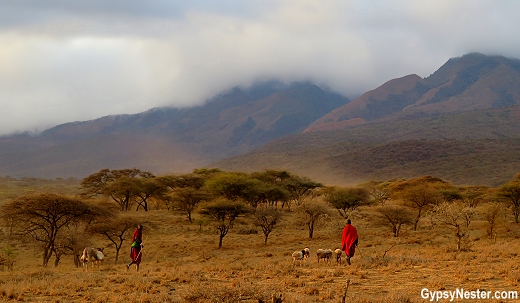
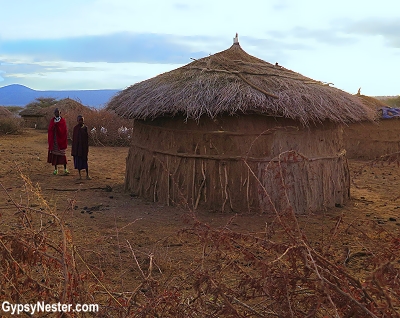
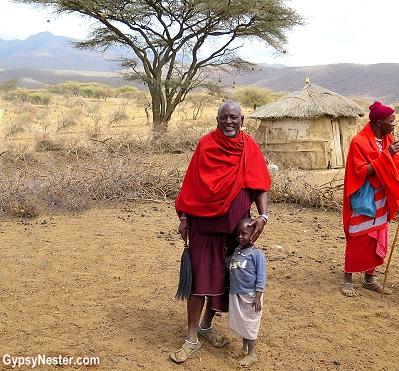
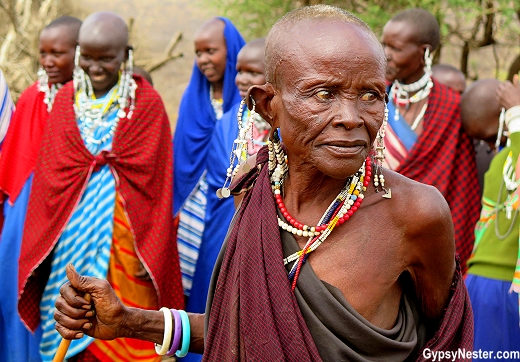
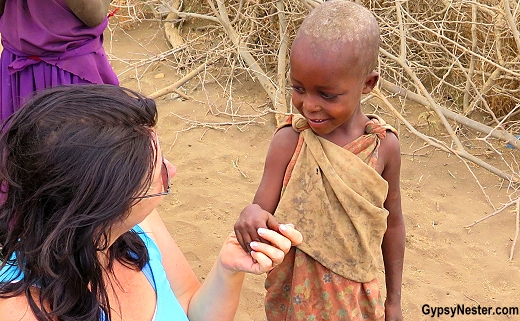
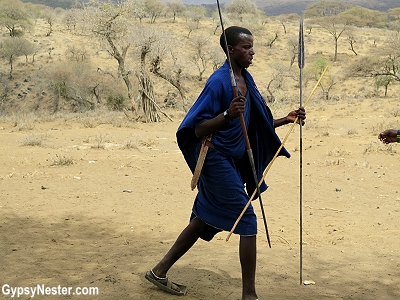
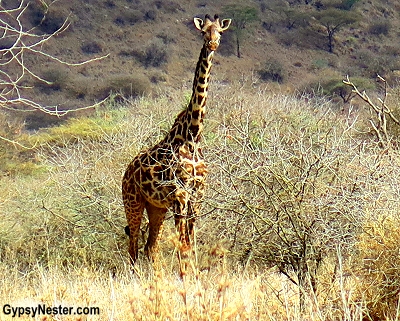

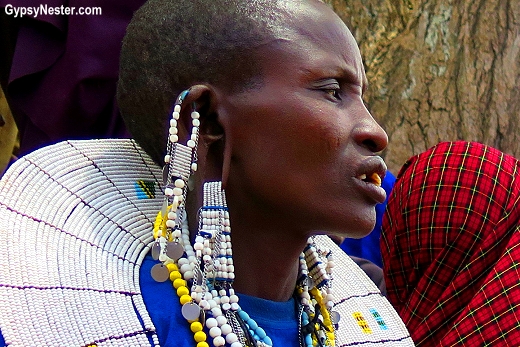
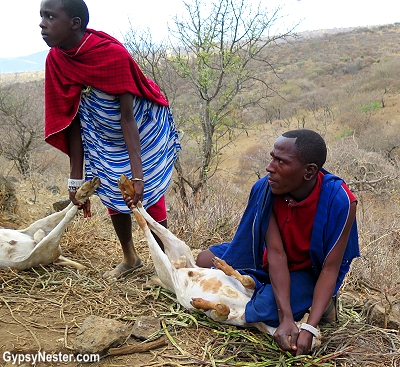
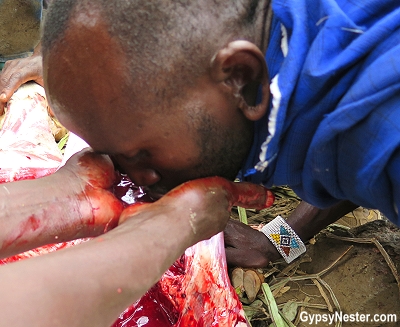
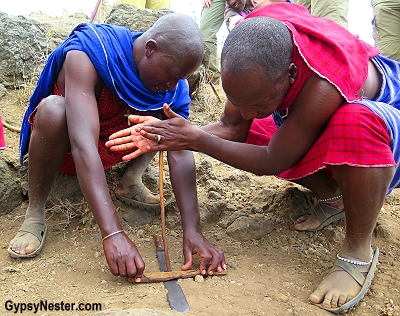
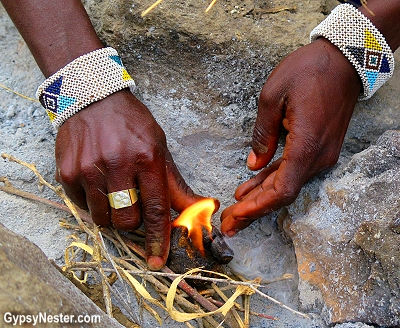
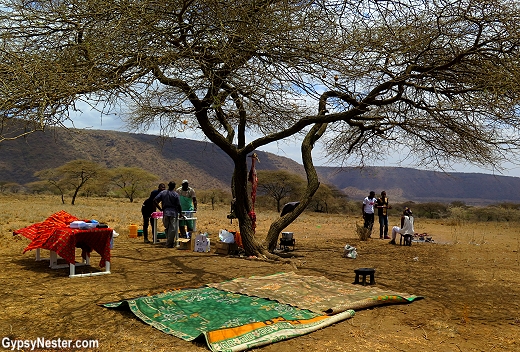
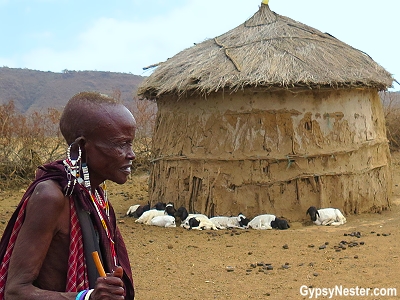

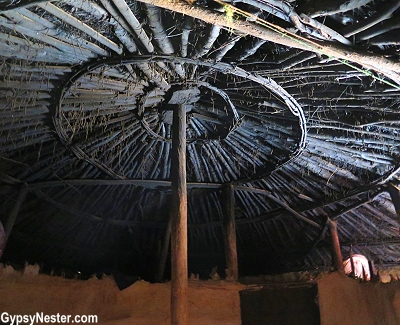
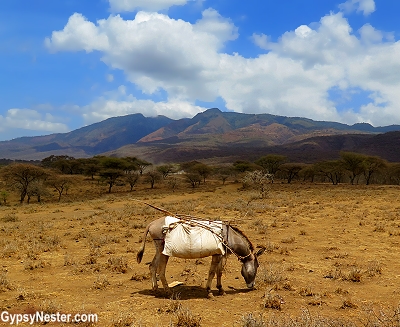
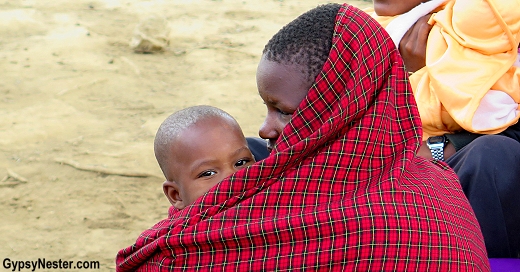

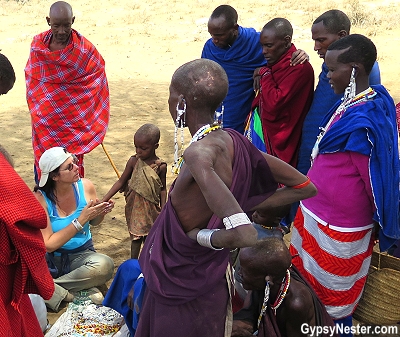

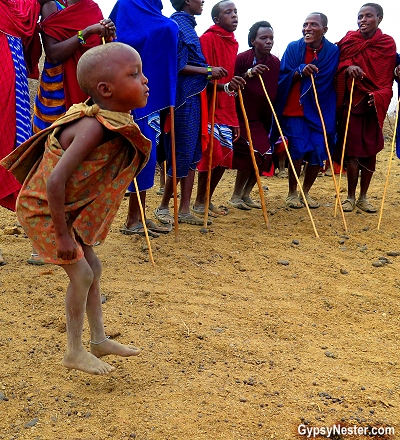
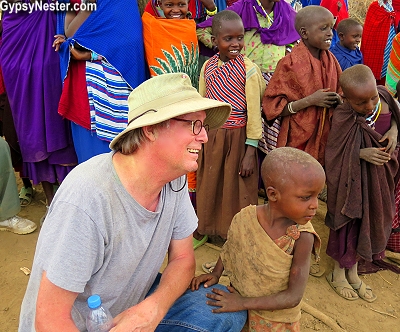

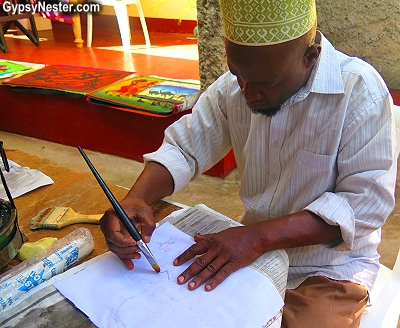

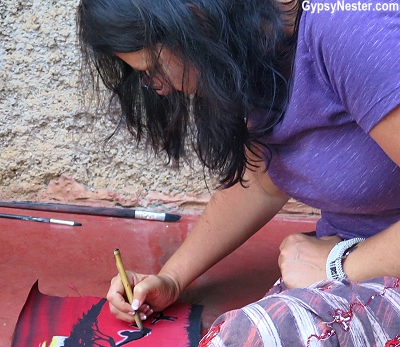
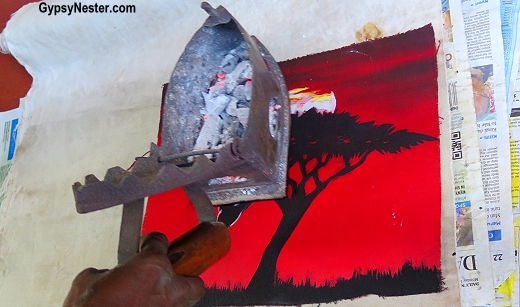
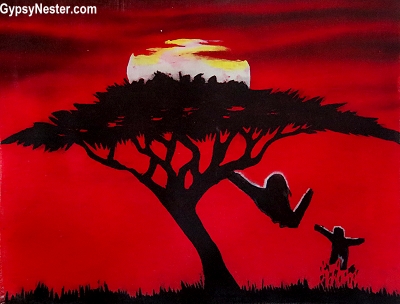
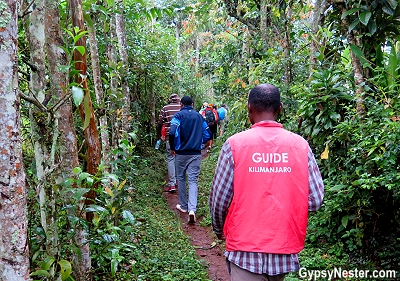
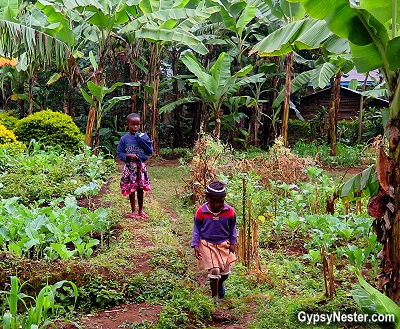
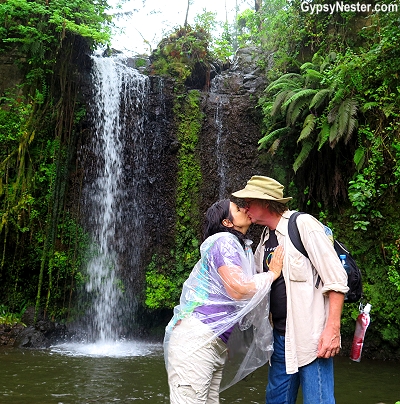
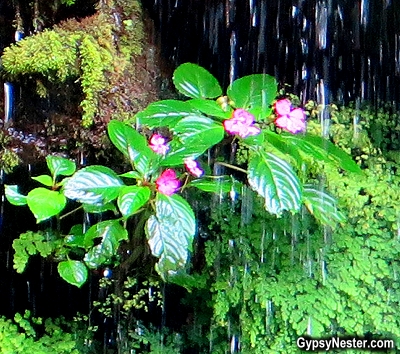
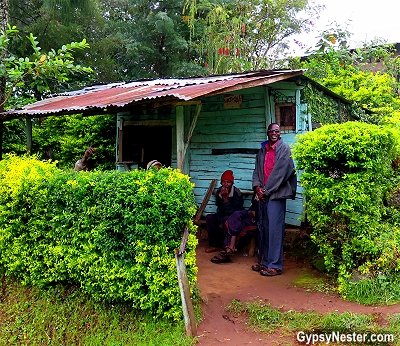

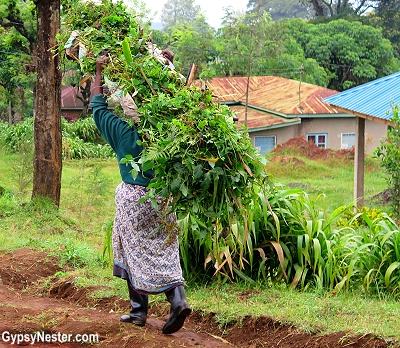
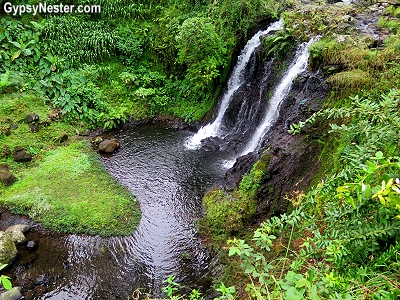

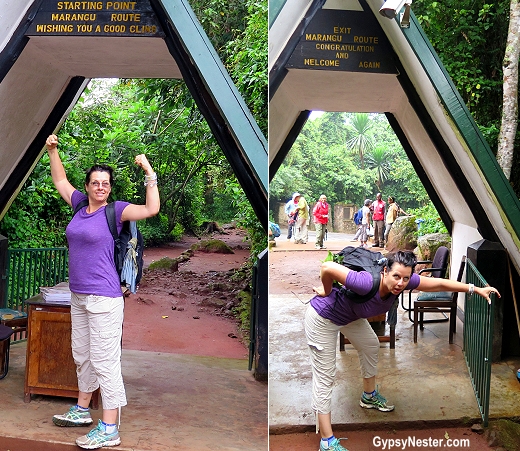
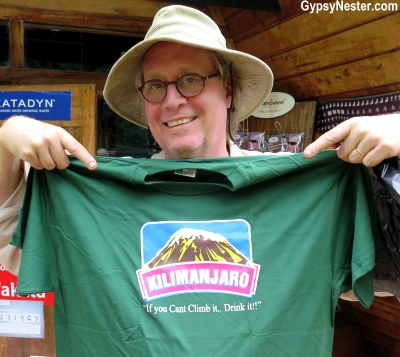

That inihsgt would have saved us a lot of effort early on.